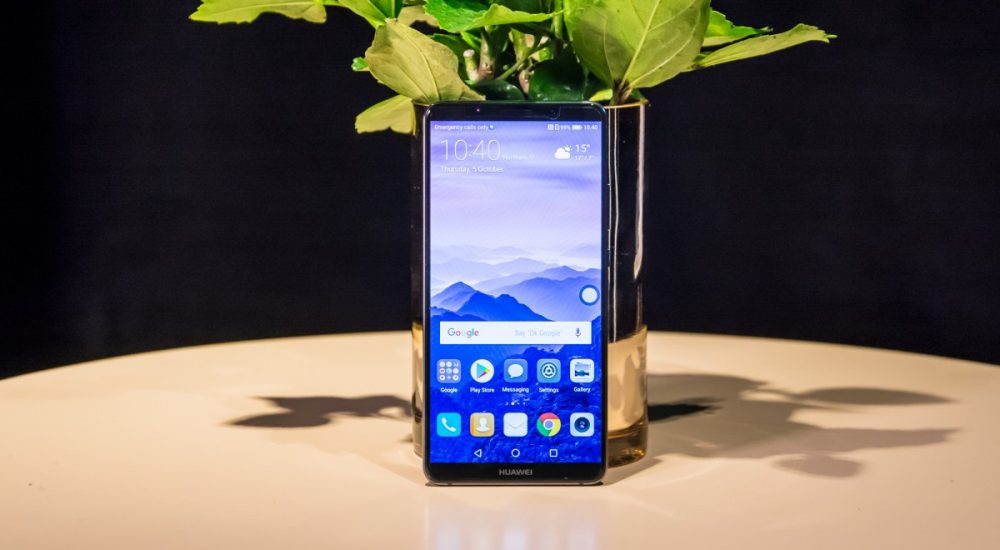When your main rival literally goes up in smoke, your shareholders should be celebrating. The recall of the Samsung Galaxy Note 7 left Huawei’s Mate 9 standing alone in a phablet-sized gap in the market – and yet the Chinese company somehow failed to fill the gap in our hearts.
The Mate 10 (and Mate 10 Pro) aims to put that right, but this time its chief rival – the Samsung Galaxy Note 8 – has put safety front and centre to ensure Huawei will have its work cut out to rival the South Korean giants.
Can the Mate 10 do it? At a recent hands-on event, we were able to get some time with a handset that’s looking very promising indeed.

Huawei Mate 10 review: Design
If you like your phablet to catch the eye for its design, and not just its size, then good news: Huawei has made big changes for the Mate 10 and they’re all for the better.
The face of the phone is dominated by a large 5.9in display, framed by a couple of extremely thin bezels at the top and bottom and even thinner ones down the left and right. Huawei has chosen to mix things up a bit colour wise, too, so as well as plain old black, you can grab the Mate 10 in “pink gold”, “champagne gold” and “mocha brown”.
Flipping the phone over reveals more big changes. Gone is the all-matte aluminium unibody, replaced with what Huawei calls “multi-axis curved glass.” What this means in human language is that the aluminium rear is still there, but it’s been covered by a layer of superheated, scratch-resistant “6H” rated glass, which stylishly bends around the sides to the front of the handset.

It’s not all positive, though. Huawei has decided to follow one regrettable trend, and ignore another wholly positive one. To that end, the Mate 10 Pro has no 3.5mm headphone jack but is waterproof. The regular model, on the other hand, keeps the headphone jack, but loses the waterproofing.
Huawei Mate 10 vs Huawei Mate 10 Pro: What’s the difference?
If that lack of waterproofing is a deal-breaker for you, you might want to consider the slightly larger, slightly more sexy Huawei Mate 10 Pro instead.
The Pro version of the Mate 10 has IP67 dust- and water-resistance, and also a slightly larger 6in OLED display. That display also has a different aspect ratio of 18:9, just like the Samsung Galaxy Note 8 and Galaxy S8 Plus, but oddly a slightly lower resolution of 1,080 x 2,160.
In all other respects, other than its higher price and the fact that it’s also available in “midnight blue”, the Mate 10 Pro is identical to its sibling: it looks the same and has the same core components inside as well.
And what about the €1,395 Porsche Design version. Is that any different? Aside from a more understated design and 256GB of internal storage, that’s pretty much the same phone, too. It’ll be manufactured on a limited run, though, so it will certainly be a more “exclusive” handset.
Huawei Mate 10: Key features and first impressions
Of course, it could be the most stunning handset in the world, but if it’s got a sloth where the processor should be, it won’t be a good pick. Unsurprisingly, this isn’t the case and the Mate 10 is suitably powerful on paper – although you’ll have to wait until we’ve had time to benchmark it fully to establish exactly how powerful.
Powering the Mate 10 is Huawei’s latest flagship processor, the octa-core 2.36GHz Kirin 970. It’s impossible to say how good that will be, as this is the first handset to have it, but the Kirin 960 in the Mate 9 was pretty speedy – even if it was a little sluggish for graphics compared to its Qualcomm Snapdragon peers.
Backing the Kirin 970 is a monster 6GB of RAM and either 64GB or 128GB onboard storage, which is expandable to 256GB if you need more.
Naturally, we couldn’t sneakily run our benchmarking software under the watching eyes of Huawei’s representatives, but the company reckons you’ll see a 20% speed increase on last year’s model. If that’s correct, this should be a phone that can fight with the best of them.

The 5.9in IPS display is a 1,080 x 2,160 unit and, in our brief time with the handset, it appeared very good indeed. The screen has a 16:9 aspect ratio, it’s bright – 30% brighter than last year – and has the added bonus of HDR 10 support.
What definitely needed improving from last year was the sub-par battery life and, on paper, nothing has changed. We’re still looking at a 4,000mAh battery, which Huawei claims will deliver two days of regular use or 20 hours of solid video playback. We’ll believe it when we see it. A lot will come down to how power-hungry the new Kirin chip is.
Once again, Leica is on camera duty with dual f/1.6 cameras on the back. One of these is a 12-megapixel RGB camera, while the other is a 20-megapixel monochrome one – just like the Mate 9.
Despite this sense of feature déjà vu, this feels like a big improvement on last year’s model, however, and while we were limited in the live testing we could do, we did find that its low-light shots were very impressive indeed.

Huawei Mate 10 review: Early verdict
So, early impressions are very promising indeed and the price looks tempting, too. With the Mate 10 coming in at €699, it undercuts most of its big-screened competition by a considerable margin. The Pro is a less-tempting €799 at launch.
At this price, it has every chance of giving the Note 8 a run for its money and if battery life and the camera are as good as Huawei says they are, we could have a winner on our hands.
Sоurсе: alphr.com




































